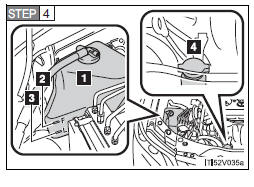Toyota Venza: If your vehicle overheats
The following may indicate that your vehicle is overheating.
• The engine coolant temperature gauge reaches the maximum, or a loss of engine power is experienced. (For example, the vehicle speed does not increase.) • Steam comes out from under the hood.
Correction procedures
 Stop the vehicle in a safe place
Stop the vehicle in a safe place
and turn off the air conditioning system, and then stop the engine.
 If you see steam:
If you see steam:
Carefully lift the hood after the steam subsides.
If you do not see steam:
Carefully lift the hood.

After the engine has cooled down sufficiently, inspect the hoses and radiator core (radiator) for any leaks.
1. Radiator
2. Cooling fans
If a large amount of coolant leaks, immediately contact your Toyota dealer.

The coolant level is satisfactory if it is between the “F” and “L” lines on the reservoir.
1. Reservoir
2. “F” line
3. “L” line
4. Radiator cap

Add coolant if necessary.
Water can be used in an emergency if coolant is unavailable.
 Start the engine and turn the air
Start the engine and turn the air
conditioning system on to check that the radiator cooling fans operate and to check
for coolant leaks from the radiator or hoses.
The fans operate when the air conditioning system is turned on immediately after a cold start. Confirm that the fans are operating by checking the fan sound and air flow. If it is difficult to check these, turn the air conditioning system on and off repeatedly.
(The fans may not operate in freezing temperatures.)
 If the fans are not operating:
If the fans are not operating:
Stop the engine immediately and contact your Toyota dealer.
If the fans are operating:
Have the vehicle inspected at the nearest Toyota dealer.
CAUTION
- To prevent an accident or injury when inspecting under the hood of your vehicle
• If steam is seen coming from under the hood, do not open the hood until the steam has subsided. The engine compartment may be very hot, causing serious injury such as burns.
• Keep hands and clothing (especially a tie, a scarf or a muffler) away from the fans and belts. Failure to do so may cause the hands or clothing to be caught, resulting in serious injury.
• Do not loosen the radiator cap while the engine and radiator are hot.
Serious injury, such as burns, may result from hot coolant and steam released under pressure.
NOTICE
- When adding engine coolant
Wait until the engine has cooled down before adding engine coolant.
When adding coolant, do so slowly. Adding cool coolant to a hot engine too quickly can cause damage to the engine.
- To prevent damage to the cooling system
Observe the following precautions:
• Avoid contaminating the coolant with foreign matter (such as sand or dust etc.).
• Do not use commercially available coolant additives.
 If the battery is discharged
If the battery is discharged
The following procedures may be used to start the engine if the battery is
discharged.
You can call your Toyota dealer or qualified repair shop.
If you have a set of jumper (or booster) cables and ...
 If the vehicle becomes stuck
If the vehicle becomes stuck
Carry out the following procedures if the tires spin or the vehicle becomes
stuck in mud, dirt, or snow.
Stop the engine. Set the parking
brake and shift the shift lever in “P”.
Stop the eng ...
Other materials about Toyota Venza:
Components
COMPONENTS
ILLUSTRATION
ILLUSTRATION
ILLUSTRATION
ILLUSTRATION
ILLUSTRATION
ILLUSTRATION
...
Replacement
REPLACEMENT
PROCEDURE
1. REMOVE CENTER EXHAUST PIPE ASSEMBLY
(a) Remove the center exhaust pipe assembly.
HINT:
Refer to the instructions for Removal of the exhaust pipe (See page
for 2GR-FE,
for 1AR-FE).
2. REMOVE PROPELLER WITH CENTER BEARING SHAF ...
Rear Airbag Sensor LH Circuit Malfunction (B1635/24)
DESCRIPTION
The side collision sensor LH circuit (to determine deployment of the front seat
side airbag assembly LH and curtain shield airbag assembly LH) is composed of the
center airbag sensor assembly, rear airbag sensor LH and side airbag sensor LH.
...
0.1289
